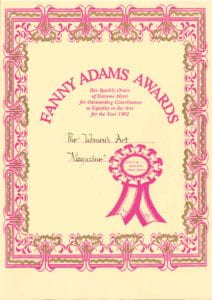
Spotlight on the Women’s Art Library
The Women’s Art Library collection was established in the 1970s to enhance public knowledge of the practice, impact and achievement of women artists. Gifted to Goldsmiths in 2003, it has become the principal collection relating to visual arts in Special Collections.
Dr Althea Greenan, Special Collections & Archives Curator, tells us more about the collection and her work here.
What is the history of the Women’s Art Library (WAL)?
“It was set up by a collective of women artists as the Women Artists’ Slide Library to raise the visibility of women’s art practice. Self-identified artists sent in their slides while artists and scholars documented exhibitions and the presence of women artists in historical collections such as the Imperial War Museum.
“The organization became an educational charity in 1983 and received arts funding over the next 18 years, developing the slide library into a research collection and publishing a newsletter that evolved into the internationally distributed Make, the magazine of women’s art.”
What’s in the collection?
“In addition to the 35mm slides, there are photographs, posters, videotapes, audiotapes, press cuttings, periodicals, ephemera and books and catalogues which you can find in the Library catalogue.
“There are different forms of artists’ archives – from the artistic work journals of Helen Ganly to the performance scripts of Clare Gasson’s ‘The River’. Nina Hoechtl’s artistic research is represented by a gold lamé costume, while the box marked ‘Food Art’ includes Paula Roush’s SOS biscuit, still uneaten, made with former employees at Bermondsey’s Peek Freen biscuit factory in 2004.
“One of the most critically important sections of the collection is the Women of Colour Index, built up by the artist, activist archivist Rita Keegan from the mid-1980s. It captures the emergence of UK black women artists at the time as curators and artists. The Women’s International Art Club archive is the oldest sub-collection and dates from 1900-1974. There is much more.”
Can it be viewed online?
“The WAL is catalogued like an archive in the Library’s Archive and Textiles Catalogue, and some collections, like the Mail Art box, have been photographed and can be viewed online, item by item. But there is no digitized version of the WAL that I consider a surrogate for the real thing.
“However, there is a gem of a pilot digital project that introduces seven artists represented in the WAL called the WAL App, downloadable from the Apple store. It was developed by alumna Dr Ana-Maria Herman as a platform for women artists to become more visible to each other and make the WAL archive travel. Ana is working on taking this project further to combine technology with advocacy for parity for women artists.”
What does your work involve?
“Facilitating researchers’ interaction with the materials includes teaching and listening, and a constant exploration of the WAL collection.
“I develop the collection by working with artists creating new work and oversee low budget publications like postcards and posters that will give a project an afterlife that becomes part of the WAL story.
“I oversee an exhibition programme that has connected the Kingsway Corridor space with Special Collections. It’s seen wonderful exhibitions by women artists in photography, print, installation and film as individuals or in small collectives.
“I work to make the WAL and Special Collections available to local art collectives needing support, and recently facilitated a podcasting day for the group Desperate Artwives.
“Items from the WAL are often out on loan as critical exhibitions looking at feminist art histories flourish around the country and there are items from the WAL’s Fanny Adams collection currently on show at the De La Warr Pavilion in Bexhill.
“The WAL contributed to the excellent Alexis Hunter show here at Goldsmiths CCA. I was delighted to contribute to the show’s catalogue, adding to other articles and chapters that I have written that introduce the WAL collection to scholarly discourse.
“I’m also asked to talk in many different settings, from self-storage units to Somerset House, and see this as an important aspect of my work of advocating for the WAL and Special Collections. I’ll be speaking on feminist archives and how cultural institutions represent women’s art practice at the Royal Academy next.”
What upcoming exhibitions will the WAL be hosting?
“Narratives of Protest will be in Special Collections during the month of March, featuring textile work by Connie Flynn commemorating the Suffragettes, a slide show of the activist Thalia Campbell’s protest banners, and selections from the Goldsmiths Textile Collection that include Catherine Walton’s triptych, ‘The Demo’.
“The exhibition will be an interesting backdrop to the screening on March 15 that is part of Advancing Women Artists around the Globe.
“The WAL is also featuring in an exhibition ‘Dark Energy: Feminist Organizing, Working Collectively’ at the Fine Art Academy in Vienna (29 Mar – 25 May) at the invitation of Dr Nina Hoechtl, a Goldsmiths alumna.
“There will be two installations: one featuring the project Empowered Printwork by the collaborative Sisters in Print (Ego Ahaiwe Sowinski and Aida Wilde) who worked with the WAL poster collection as part of the Goldsmiths project Radical New Cross.
“The second installation will feature a collection of films, screen-recording, art writing and prints titled Slidewalking into the Disoeuvre, which is a long-term collaborative project between myself and the artist-educator Dr Felicity Allen. The installation looks at how the WAL epitomises the idea of the archive as a dark energy that questions whose ‘knowledge can be practiced, produced, and disseminated when, where, and how?’”
How can staff keep up-to-date with what’s happening at the WAL?
“We put all our college exhibitions and events on the Goldsmiths calendar. I also have an email list to update on the wider range of activities. Just email me at a.greenan@gold.ac.uk or people can sign up to a Special Collections mailing list. Scroll down to the bottom of the page of https://www.gold.ac.uk/library/special-collections/
Special Collections is open Monday – Friday, 10am-6pm.”
Leave a Reply